|La Révolution Française de 1789|
French Revolution Timeline : we describe the French Revolution, taking place between 1789 and 1799, as a huge rupture, abolishing the monarchy, inventing new social relations and creating a new political order. This upheaval is the peak of revolutionary movements occurring in Europe and North America at the same time, attracting reformers from these countries to it. The violence expressed in a particularly strong way accentuates changes. The French Revolution thus alone embodies an era in the history of Europe and the world, breaking the chain of times.
The origin of the French Revolution
The causes of the French Revolution encompassed social dissatisfaction, political oppression, acute economic crisis, and the rise of Enlightenment ideas. During the reign of King Louis XVI of France (r. 1774–1792), the first two orders enjoyed a significantly greater degree of privilege than the third, although the latter represented more than 90% of the French population and paid almost all taxes. The Third Estate itself was divided between the rising middle class, known as the bourgeoisie, and the increasingly impoverished working class, known as the sans-culottes. As social inequality worsened, tensions between these orders and the Crown, as well as between them, were one of the most important causes of the French Revolution timeline (1789-1799). From the meeting of the Estates General in May 1789, the question of social classes remained a dominant theme throughout the Revolution.
Orders in the Middle Ages: the clergy, the nobility and the third estate.
It was in the Middle Ages that the 3 social orders were established. Each social order was recognized by clothing and hairstyle. Officially, they were named and described by an 11th century monk, although they describe early medieval society very well. This hierarchy, divided according to people’s closeness to God, was still in place at the start of the French Revolution.
The Clergy
Those who devoted their lives to God and prayer deserved the first rank. Servant of God and invested with divine power on earth, the clergy was made up of all hierarchical levels of churchmen: bishops, priests, monks. The Early Middle Ages are also characterized by the beginnings and expansion of monastic life. Governed by strict rules, the monks’ lives focused mainly on prayer, religious chants, the study of sacred texts and manual labor. Several of them copied manuscripts.
Monks and members of the clergy were for a long time the only custodians of ancient culture. They were the ones who participated in the development of a new definition of Western culture based on Christianity. The Church thus regained control of spiritual life by imposing a Manichean vision of the world in which God and the Devil are opposed.
The Nobility
Those who fight form the second section of society. Not devoting their lives to God, they nevertheless deserved a place of distinction thanks to their involvement in power and in wars and also because of their duty of protection. Nobles in this case are “the titles of prince, duke, count, marquis, viscount, vidame, baron, knight, lord, squire, noble, and all other similar titles”.
The nobility formed a closed group, bringing together both poor and powerful lords. She is responsible for the management of the territory and the administration of people. The territory is crisscrossed by a tight network of castles which stand every 3 or 4 km. Some are imposing, others are just simple towers where no one resides except temporarily, to collect taxes, or “strong houses”, noble residences sometimes barely fortified. This restrictive power of the nobles is characterized by the control over peasant men, over space and over the means of production.
While the nobility is a legal and social state, the second order of the monarchical organization, after the clergy and before the third estate, the aristocracy has, in 1789, a political meaning: it designates the “privileged”, the ” party” (in the broad sense) of all those, nobles, prelates or great bourgeois
The third Estate
Those who worked, although representing almost the entire population (80 to 90% of the population), were called the third estate. This category was made up of the people, namely peasants, artisans, merchants and workers. At that time, working the land was considered degrading. Members of the third estate did not have the leisure to devote their lives to noble causes, they were more busy ensuring their survival and meeting their basic needs.
The Third Estate must pay taxes such as the tax to the king, the tithe to the clergy and the seigneurial rights to the nobles. Under the Ancien Régime, tax paid by commoners (i.e. those who are not noble) intended to finance the king’s standing army.
Christian economic and political network
In the 12th century, with the growth of towns and trade, this tripartite pattern became more complex: artisans and especially merchants became essential players in medieval life; seigniorial power weakens; chivalry tends to disappear and is no longer, in the 15th century, anything other than the occasion for beautiful tournaments and magnificent passes of arms. To this secular network, both economic and political, is added that of the Church which, around the 11th-12th centuries, completed the establishment of the system of parishes by offering the faithful its churches, its baptismal fonts and its cemeteries . Chapels, crossroads, crossroads punctuate the landscape.
The concept of serfs from the Latin servus, slave
At the beginning of the Middle Ages, on the fringes of the free peasantry, a minority of villeins (peasants) lived in complete dependence on the lord (castle, abbey or other). They suffer from a unique form of servitude, “servitude” (from the Latin servus, slave).
Lord and peasants
Deprived of freedom and even obliged to obtain the consent of their master to marry, the serfs were hereditarily attached to the lordship. They have no right to leave it. Reciprocally, the lord cannot drive them out or take away his protection. This is what makes the difference with conventional slavery. Naturally, emancipation and franchises were granted in return for money: the lord gives up vexatious rights for the peasants, of little benefit to him, in exchange for large sums of money.
Serfdom difficult definition
The term “serfdom” covers a reality that is difficult to grasp and varies in time and space. In the 11th century. and at the beginning of the 12th century, the difference between the free man and the serf was blurred. Serfdom did not have the same importance depending on the place. It was very widespread, in the 12th century, on a strip of land extending from the Loire region to southern Germany, via Champagne and Lorraine. However, serfdom did not exist in Normandy, in most of Picardy, in Saxony, in Lombardy. While serfdom disappeared from Western Europe during the modern era, it developed in the countries of Central and Eastern Europe which had not known it until then. It was not abolished in Austria-Hungary and Russia until the 19th century. (1861, by Tsar Alexander II).
Even today, certain forms of peasant dependencies can be similar to serfdom, if not even slavery (Mauritania, Saudi Arabia, or peasants on the large fazendas of the Brazilian Northeast, for example).
By the Edict of August 8, 1779, King Louis XVI abolished serfdom (that is to say “personal and real servitude”) on the royal domains of France. This order was favored by the intervention of Voltaire, who in 1778 had pleaded the cause of the serfs of Mont-Jura and the abbey of Saint-Claude at the end of his life.
In 1789, France experienced a period of major crisis. The harvests were poor and the price of bread reached new heights. Work is becoming scarcer, the purchasing power of the poorest is plummeting and they are faced with several episodes of famine and revolt is brewing.
French Revolution Timeline and the Enlightenment
The question of the relationship between the French philosophy of the Enlightenment and the French Revolution is as old as the Revolution itself. It continues to be present among the actors of the Revolution, not only through the references to the great authors, but also through the public tributes with which they are honored, as evidenced for example by the installation of a bust of Voltaire to the Constituent Assembly or the transfer of Rousseau’s remains to the Pantheon.
From 1788 to 1804 French revolution timeline :
On August 8, 1788, the king summoned the General States for May 1, 1789. In preparation for this meeting, more than 45,000 notebooks of grievances were drawn up throughout the kingdom so that the people could make their demands known.
-
French revolution timeline of 1789 : The big turn
On April 28th, 1789, in Faubourg Saint-Antoine street of Paris, the misery is so colossal that a riot arises like a thunderbolt. The revolution is on its track !
On June 20, 1789, part of the deputies decided to form a constituent assembly. In the Salle du Jeu de Paume of Versailles, they promise to never separate and to assemble wherever circumstances require, until the Constitution of the kingdom is established on solid foundations.
The question of the vote by order or the vote by head agitates the meeting of the General States. The clergy and aristocracy are certain to win against the third estate composed of the commons, in other words, the workers, the peasants but also the reformers, the bourgeoisie and traders. Tired of the deliberations, the king ordered the dispersal of the deputies who, at the instigation of Mirabeau, refused to leave the room.
“Do they want to stay? Well, let them stay! » Louis XVI, on the evening of June 23, 1789.
On July 11, 1789, the king dismissed his Minister of Finance, Necker, considered as a reformer. His dismissal is seen as a sign of hostility to power and will ignite the powder.
“The small town of Paris is as bustling as one can wish. We get weapons everywhere (…); 600 barrels of powder are seized from a boat on the Seine (…). The king’s furniture is attacked, and the weapons in it are distributed (…) ” Governor Morris, United States Ambassador to France.
On July 14, 1789, the crowd went to the Bastille to search for weapons, fearing that they would be attacked by royal regiments. This prison is commanded by M. de Launay, the embodiment of absolute power, the king himself, who orders his garrison to fire on the rioters: 100 people perish. The Bastille eventually surrendered under the pressure of the besiegers.
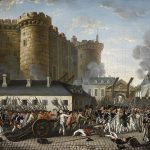
Bastille’day
On the night of August 4, 1789, the clergy and the aristocracy renounced their privileges, the third estate won’t have to pay taxes anymore to them but riots continued while the Constituent Assembly was seated. The Constituent Assembly of 1789 or National Constituent Assembly is the first French constituent assembly, instituted by deputies from the General States when they set themselves up as a “National Assembly” on June 17, 1789, birth of the French representative system.
On the August 26, 1789, it is The Declaration of the Rights of Man and of the Citizen. This Fundamental text of the French Revolution sets out individual and common natural rights, as well as the conditions for their implementation. The Declaration was originally drafted by Mirabeau, Mounier, Talleyrand, the Marquis de Lafayette, in consultation with Thomas Jefferson. It is included in the beginning of the constitutions of both the Fourth French Republic (1946) and Fifth Republic (1958) and is still current. Inspired by the Enlightenment philosophers, the Declaration is a core statement of the French Revolution values and had a major impact on the conceptions development of individual liberty and democracy in Europe and worldwide.
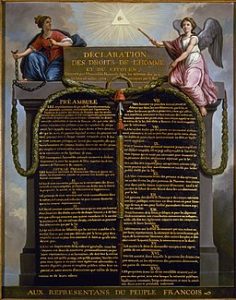
The French Declaration can be compared to the preamble to the Declaration of Independence of the United States of 1776, in particular “all men are created equal. When the first American constitution was drafted in Virginia, it was inspired by the declaration of Rights of 1689, and the works of British philosophers (John Locke, Henry Home, Thomas Hobbes) as well as of enlightenment philosophers (Charles de Montesquieu, Diderot, d’Alembert, Rousseau, Voltaire), read by the actors of the American Revolution, such as Benjamin Franklin or Thomas Jefferson.
On October 6, 1789, the crowd invaded Versailles and forced the Versailles departure of the king under the protection of Lafayette, whom escorted the royal family to the Tuileries Palace in Paris.
-
French revolution timeline of 1790 : Birth of a nation
On July 14th, 1790, Talleyrand, d’Autun bishop, active member of the constituent assembly, with hundreds of priests celebrate a mass in honor to the new nation. This is organized by Lafayette. With the king Louis XVI, they take an oath to the nation and the constitution. The legislative body in France until 1789, represents the 3 estates of the kingdom (the clergy, the nobility, and the commons).
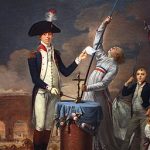
Oath of Lafayette
On October 21, 1790, the tricolor flag replaced the royal flag. However, divergent voices have been heard since April against the Revolution. Before being a flag, the tricolor was a cockade. It is said that it was La Fayette who gave Louis XVI, 3 days after the storming of the Bastille, a tricolor cockade, declaring: “I bring you a cockade which will go around the world”. White represented the monarchy, while blue and red took up the colors of the city of Paris.
-
French revolution timeline of 1791 : Freedom
The question of the colonies and their slaves agitates the benches of the Constituent Assembly where some, including Robespierre, are in favor of the abolition of the slave trade and slavery. The status of the Jews is also a source of debate in the Constituent Assembly.
Women are always forgotten. They do not vote and they have not representatives and some grapple with this political issue head-on.
“Women have the right to climb the scaffold; she must also have the right to go up to the rostrum. » Olympe de Gouges (1748-1793), Declaration of the rights of women and citizens, September 1791.
June 1791, pushed by his supporters, the king with queen Marie-Antoinette and the royal family tries to escape abroad. Recognized on the road, the king was arrested in Varennes and brought back to Paris. His good faith is now disputed and, with it, the very idea of royalty.
-
French revolution timeline of 1792 : Facing the enemies
On April 15, 1792, Liberté, Égalité, Fraternité (Liberty, Equality, Fraternity) becomes the motto of the French Republic. The freedom and equality of men are laid down as a principle in France in article 1 of the Declaration of the rights of man and of the citizen of 1789.
On April 20, 1792, France declared war on Austria. The king and his family are placed under surveillance since the escape. The Duke of Brunswick is appointed commander of the allied Austrian and German army united to invade France and to crush the French Revolution. He commands the coalition army entered in France to defend the monarchy, threatening in July :
“If there is done the least violence, the least insult to their Majesties, the king, the queen and the royal family, if it is not immediately provided for their safety, their conservation and their freedom, [the imperial and royal majesties foreign] will take a vengeance from it exemplary and forever memorable. » Charles Guillaume Ferdinand of Brunswick.
The Duke of Brunswick’s declaration had the opposite effect to that expected: on August 10, the people invaded the Tuileries. Many people are killed, the king is a prisoner and will be tried.
The army of the united European monarchies continues its inexorable march towards the capital.
On August 1792, La Fayette lost his influence by threatening the people to lead his army against the Parisian revolutionaries. Declared traitor to the nation, he has no other choice to emigrate. He will be back to France in 1799.
On September 3, 1792, an unleashed crowd landed at the Force prison where the Princess of Lamballe, governess of the royal children and friend of Queen Marie-Antoinette, was detained. His body is torn to shreds, his severed head paraded on a pike all over Paris. This horror scene is replayed in several prisons in the capital. Galvanized by the journalist Jean-Paul Marat who agitates the fear of an invasion, the sans-culottes come to lynch the counter-revolutionary inmates. Danton leading figure in the early stages of the French Revolution lets this massacre go on. These are the September massacres.
On September 20, 1792, it is the French victory of Valmy against the Prussian forces.
On September 25, 1792, the Republic was declared “united and indivisible”. From 1792 to 1802, France was at war with the rest of Europe.
-
French revolution timeline of 1793 : The Terror
On January 21, 1793, the king Louis XVI was guillotined place de la Révolution (place de la Concorde nowadays).
On April 6, 1793, the Committee of Public Safety under Danton was created to coordinate the actions of other committees that act as ministries. In addition to border disturbances, there are now civil wars with the insurrection in the Vendée. If in 1791 the Civil Constitution of the Clergy provoked strong discontent, in March 1793, the Vendée rebellion broke out (North West of France by Britany), at first like a classic peasant jacquerie, before taking the form of a counter-revolutionary movement.
Marat also unceasingly denounces the vigorously Girondin warmongering in L’Ami du peuple, his newspaper. On July 13, 1793, while taking a bath to treat his eczema, Marat was assassinated by Charlotte Corday, linked to the Girondists. She is condemned to death. On October 31, 1793, 22 Girondins were guillotined.
Marie-Antoinette, symbol of the Ancien Régime and incarnation of evil for the Revolution is transferred to the Conciergerie. On October 15, 1793, after a hasty trial, she was sentenced to death for the crime of high treason. She was executed on October 16 at a quarter past twelve place de la Révolution (place de la Concorde nowadays next to the jardin des Tuileries).
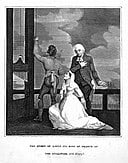
Marie Antoinette, Queen of France, kneeling before the guill Wellcome
-
French revolution timeline of 1794 : The Purges
The Revolution has always more enemies and, far from softening, it accentuates the repression against the seditious or perceived as such. The Committee of Public Safety becomes the real organ of government. Soon, the Terror will succeed the “Great Terror” and the fall of Danton and Robespierre.
In March 1794, the Girondins called the “exaggerated” were arrested and were brought to the Revolutionary Tribunal from March 21 to 24, 1794. They were all condemned to death. The “exaggerated” eliminated, it is the turn of the “indulgent”. Desmoulins Danton, and even Fabre d´Eglantine were arrested on March 30. Danton had been advised to flee, but he had refused. He will be executed on April 5th.

Portrait of Danton
On June 8, 1794, the cult of the Supreme Being is, in France, a cultural need, which was manifested by a set of civic and religious events and festivals by Robespierre. The cult of the Supreme Being also proceeds from the deism of Voltaire and the Christian theism of Rousseau, from which Robespierre was inspired. Philosophically, the cult of the Supreme Being corresponds to a natural religion, a concept born in the Age of Enlightenment. Deism is a belief or a doctrine which defends the rational affirmation of the existence of God, proposing a religious form in accordance with reason.
Deism proposes to reach God – a God of reasoning rather than a God of faith or worship – by exclusively human ways. In fact, it can take different definitions. The cult of the supreme being was not a religion, as mentioned in the Decree of 18 Floréal Year II, but a set of festivals intended at the request of the people, to make them realize that they are sovereign in their country. The Supreme Being is explicitly referred to in the preamble to the Declaration of the Rights of Man and of the Citizen of 1789, which is a pillar of the French legal, political and social system.
In July 1794, Robespierre and his supporters were executed. Their executioners attribute to them the excesses during the Revolution. A young Corsican general, close to the Robespierrists, is questioned by representatives on a mission:
“In a revolutionary state, there are two classes, the suspects and the patriots. » Napoleon Bonaparte, July 1794.
-
1795 : The Directory
The royalists raise their heads and want an insurrection. In the fall of 1795, Napoleon Bonaparte is charged to restore order. On 13 Vendémiaire, he fired with his army at the demonstrators near the Saint-Roch church in Paris : 300 dead. The legend was made : “General Vendémiaire”. On October 26, 1795, a new regime succeeded the Convention: the Directory.
On 4 Brumaire Year IV (October 26, 1795), the Convention gave way to the Directory. By this change of regime, the moderate conventionals, or Thermidorians, who overthrew Robespierre on 9 Thermidor Year II (July 27, 1794) want to signify the end of the Terror and the Revolution.
The new regime begins by decreeing a general amnesty. It abolishes all legal proceedings “relating to facts purely relating to the Revolution”.
Symbolically, the Place de la Révolution, formerly Place Louis XV, changes its name to Place de la Concorde. This is also the name of this high place in Paris where the guillotine was installed under the Terror.
-
1799 : The epilogue
Bonaparte, who shone in the campaigns of Italy and Egypt, carried out a coup d’etat on November 9, 1799. He established the Consulate. This is the end of the first revolutionary period.
The Consulate is the period in the history of France between the coup d’état of Brumaire Year VIII (November 1799) which ended the Directory and the establishment of the First Empire in May 1804. The First Consul Napoleon Bonaparte established his authoritarian personal power. To end to the uncertainties of the revolutionary period, and to ensure the power of the bourgeoisie, he created administrative, financial, religious, social and civil institutions which still serve nowadays. These new institutions will be imposed or imitated in Western Europe in the nineteenth century. It is also the continuation of the revolution’s wars against the kings of Europe. Choose a Napoleon private tour guide with PARIS BY EMY.
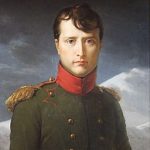
Château de Chantilly, François Gérard, portrait of Napoleon Bonaparte
I hope you enjoy this French revolution timeline. The philosophy of the Enlightenment is held to be inseparable from the Revolution. Enjoy a French Revolution private tour for your Paris Trip with in option a Paris private driver.
Emy,

